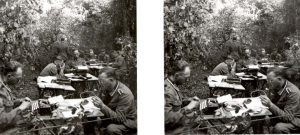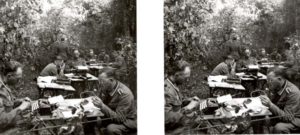Heute ist es selbstverständlich, dass ein PC Sound in Höchstqualität ausgibt. Die Rechnergeneration der 1980er und frühen 1990er Jahre kannte allerdings nur den PC-Lautsprecher. Über ihn gab das System Warnlaute von sich, die dann auch an Qualität nicht mehr zu erwarten ließen. Nur mit Soundkarte gab ein PC akustische Genüsse von sich, fehlte diese, blieb er stumm. Ein kleiner Treiber machte es unter Windows 3.x und Windows 95 allerdings möglich, dass der für die Soundkarte gedachte Klang über den PC-Speaker ausgegeben wurde. So konnte man immerhin erkennen, wenn das System einen für die Soundkarte gedachten Klang ausgab.
Bürgerkriegsähnliche Zustände in Sachsen? Neue Regionalstudie zur politischen Gewalt in der Endphase der Weimarer Republik erschienen
Eine Rezension zu Gerhard Lindemann/Mike Schmeitzner (Hgg.): „… da schlagen wir zu&ldqu...
Form Follows Function │ Stilmittel in der Bibel
Die meisten unserer modernen Texte sind vermutlich sehr viel inhaltsorientierter als die antiken. Wi...
VR Tutorials – Neue Video-Reihe zu Virtueller Realität und deren Einsatz in Bildungskontexten
Von Ingo Kleiber Wer sich in den in den letzten Jahren mit der digitalen Transformation auseinanderg...
Quelle: https://hse.hypotheses.org/2533
23. April 1620: Ist Prag ein Abendmahl wert?
Die böhmische Königin war in Nöten. Einigermaßen gewunden wandten sich Elisabet...
EMQuon — The Early Modern Quarantine Conference
With so many conferences cancelled these days Joe Saunders had a particularly refreshing idea to be played out on the internet: To host the first Early Modern Quonference on Twitter.
We have decided to join the event with a call for data to present in a special data drive session on the event.
Whom would we like to attract? With a deadline on May 1st all those who should have data at their fingertips. If you have data silently passing away on old spreadsheets, decomposing on massive antiquated hard disc drives, rotting on databases islands without a download button… this is the moment to fuse them into the collaborative resource and to check whether we cannot link them to far more data on the growing community platform.
This is Joe’s announcement
EMQuon
|
“Juden unter sich”
One of the most influential anti-Semitic propaganda actions produced in the Third Reich in the years 1939-1941 was based on images and reports from various ghettos in occupied Poland. Large portion of the raw material required for the anti-Semitic propaganda was collected and delivered by the Propagandakompanien (PK) of the Wehrmacht.[1] In order to analyze and understand the significance of this contribution, it is necessary to look not only at the propaganda materials, but also at the historical contexts in which they were produced. This includes organizational aspects, local conditions, general propaganda strategies and the given general and local war situation.
This article will examine the contribution of the Wehrmacht to the anti-Semitic propaganda of the “Third Reich” during three periods: The invasion of Poland, the establishment of a new order in the occupied Polish territories and the months preceding “Operation Barbarossa” in 1941. It will focus on the way PK materials were used mainly in the visual media in order to support the propaganda strategies and their subsequent goals set by the Nazi leadership.
General remarks regarding the propaganda organization of the “Third Reich”
[...]
“Juden unter sich”
One of the most influential anti-Semitic propaganda actions produced in the Third Reich in the years 1939-1941 was based on images and reports from various ghettos in occupied Poland. Large portion of the raw material required for the anti-Semitic propaganda was collected and delivered by the Propagandakompanien (PK) of the Wehrmacht.[1] In order to analyze and understand the significance of this contribution, it is necessary to look not only at the propaganda materials, but also at the historical contexts in which they were produced. This includes organizational aspects, local conditions, general propaganda strategies and the given general and local war situation.
This article will examine the contribution of the Wehrmacht to the anti-Semitic propaganda of the “Third Reich” during three periods: The invasion of Poland, the establishment of a new order in the occupied Polish territories and the months preceding “Operation Barbarossa” in 1941. It will focus on the way PK materials were used mainly in the visual media in order to support the propaganda strategies and their subsequent goals set by the Nazi leadership.
General remarks regarding the propaganda organization of the “Third Reich”
[...]
Journalismus nach Corona
Diese Krise, da ist sich Heribert Prantl sicher, „bringt einen auf verrückte Gedanken&ldq...
Plastikvermeidung als individualisierte Alltagspraktik: zwischen Entpolitisierung und Mikropolitik
von Lukas Sattlegger Plastikverpackungen und Plastikvermeidung haben als ges...

